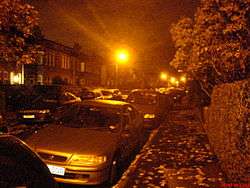Strathbungo
| Strathbungo | |
 The view from the Moray Place end of Vennard Gardens at night |
|
 Strathbungo |
|
| OS grid reference | NS579627 |
|---|---|
| Council area | Glasgow |
| Country | Scotland |
| Sovereign state | United Kingdom |
| Post town | Glasgow |
| Postcode district | G41, G42 |
| Dialling code | 0141 |
| Police | Scottish |
| Fire | Scottish |
| Ambulance | Scottish |
| EU Parliament | Scotland |
| UK Parliament | Glasgow Central |
| Scottish Parliament | Glasgow Southside |
Coordinates: 55°50′12″N 4°16′14″W / 55.83654°N 4.27057°W
Strathbungo grew up as a small village built along the Pollokshaws Road, one of the main arteries leading southwards from the centre of Glasgow, adjoined by the Camphill Estate, now part of Queens Park. The village never achieved burgh status and was annexed to Glasgow in 1891. Strathbungo lay just inside Govan parish, on its boundary with Cathcart parish, and at one time the line of Allison Street and Nithsdale Street formed the boundary or 'march' between the counties of Lanark and Renfrew.
Strathbungo was formerly known as Marchtown, and this survives in March Street. The words 'Strathbungo Cross' appear on a tenement at the corner of Allison Street and Pollokshaws Road, but no satisfactory explanation has ever been given for the name Strathbungo, as 'Strath' (from Scottish Gaelic: Srath) is normally prefixed to a river, to name the surrounding area. However, there is no river Bungo. "Bungo" may represent a nasalisation of Mungo, the patron saint of Glasgow, from Srath Mhungain.
Strathbungo developed as a crofters and miners village in the early 18th century. By the end of the 19th century, over 35 families were living in the village and weaving had become the principal occupation.
In 1859 development of a residential suburb to the south west of Strathbungo began, when nos 1-10 Moray Place were built to the design of Alexander Thomson. The other terraces (named, as was Moray Place, after the protagonists in the Battle of Langside fought nearby), Regent Park Square, Queen Square and Princes Square (later renamed Marywood Square), formed a private estate, exclusive enough to have gates. This part of Strathbungo was designated a conservation area in 1973. In the 1890s Charles Rennie Mackintosh lived at 27 Regent Park Square.
In Alexander Thomson’s death notice published in the Glasgow Herald of 23 March 1875, his place of death is described as "1, Moray Place, Regent Park" with no reference to Strathbungo, which is perhaps a later preference for the name of the wider area.
By the 1870s tenement buildings had started to appear, and with annexation to Glasgow in 1891 building proceeded apace.
Strathbungo railway station opened on 1 December 1877, and closed on 28 May 1962.
The Strathbungo Society helps promote the preservation of the Strathbungo Conservation Area and organises events for local people like 'Bungo at the Bells' at the New Year and the 'Bungo in the Back Lanes' event in June each year which was originally set up to help get people into the lanes in Strathbungo and to highlight the need for the refurbishment of them.
External links
- Maps of grid. ref. NS579627
- The Strathbungo Society's BungoBlog
- Strathbungo & Crossmyloof - Origins and History
- Southside Festival
- Southside Happenings